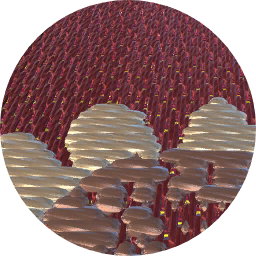Description
Huipil panel, hand-woven cotton brocaded with cotton, wool and silk, made in Guatemala, 1875-1890.
Two panels for a huipil, probably not intended for the same huipil as there are marked differences in the size, design, threads and ground colour in each piece. These are expensive, well-woven panels made of the natural, undyed cotton known as Gossypium Mexicanum and decorated with a great number of different types of thread. They were woven on a backstrap loom and therefore have four selvedges each; in contrast to the red tzute displayed on the left (T.35-1931), the area of loosely packed weft is difficult to discern, it is about 1" from the lower edge.
The panel on the left (T.33-1931) is the most complex textile in the Maudslay Bequest: eleven different types of thread have been used to decorate it: red, yellow, light green and dark blue cotton, a little red wool, yellow floss silk (faded to cream), light blue, light purple, black and white floss silk and a tightly and regularly spun purple cotton (S3Z) which was undoubtedly machine-spun. Dye analysis has shown that the red cotton was dyed with Alizarin and the purple silk with cochineal. The machine-spun purple cotton was dyed with purpura patula, an expensive dye obtained from a shell-fish. Cohcineal had been used to dye the purple silk in this piece and in the headcloth displayed in the case opposite (T.31-1931), but cochineal would not take on cotton and so the expensive purpura patula has been used.
Only eight different types of thread were used in the panel on the right (T.34-1931), the following ones are not found: red wool, light blue floss silk and black floss silk. []
This panel comes from a huipil, a blouse-like garment that forms part of the traditional dress worn by Guatemalan women. Huipils are hand-woven by the women themselves, usually on a portable 'back-strap' or 'belt' loom, which is secured around the waist of the weaver, enabling her to continue weaving when opportunity and time permit. Huipils are very simply constructed; they consist of a woven cotton or wool rectangle with an opening left at the top for the head, much like a tunic. The weave is either plain or brocaded, which can then be embroidered or appliquéd if further decoration is desired. Patterns are often particular to the weaver's village or region and are therefore a useful clue to the huipil's origins.
Panel, red and purple, from a huipil, a blouse-like garment that forms part of the traditional dress worn by Guatemalan women. The panel is hand-woven in cotton brocaded with cotton, wool and silk.
1931 Description: Panel (possibly from a skirt) of silk and cotton on brown cotton, darning stitch. The panel is embroidered with two wide bands of zigzag pattern in red, green, dark blue and mauve cotton and white silk. The rest of the ground is powdered with rosettes, arrow-heads and spots.
1975 Description: One panel of a huipil. T.33 and T.34-1931 are not panels from a skirt but two halves of an Indian blouse from the village of Totonicapan or the surrounding area. They would have been sewn together with a hole cut out for the head and slits left in the side seams for the arms. It is not uncommon to have the two halves of a huipil as different in size as these two are, as they were woven separately. A similar garment made up of two such different sized panels is illustrated in L M O'Neal's 'Textiles of Highland Guatemala' plates 95a and 95b; see also p.304.
Plain weave ground made of natural undyed cotton known as CUYUSCATE or IXCACO (Gossypium Mexicanum). This cotton has always been highly valued by local weavers. The woven design is both single faced and double faced brocade weaving done with white and mauve silk and several colours of cotton. Several pattern yarns are used together in each pick so the pattern stands out from the ground cloth. These pieces are woven on a backstrap loom and therefore have 4 selvedges each.
Dye Analysis (Carlsen and Wenger, undertaken 1988, published 1991):
The red cotton was dyed with Alizarin, the red silk was dyed with cochineal and the purple cotton with purpura.
Technical Details (1995)
Warp: 46 threads per inch; brown cotton; Z-spun, unplied.
Weft: 24 threads per inch; brown cotton; Z-spun, unplied. there is some red cotton weft (Z2S), loosely spun, which has relaxed and looks like 2 parallel threads along the lower and upper edges. There are loosely packed weft threads about 1" from the lower edge as numbered.
Lower Edge: 9 passes of red cotton.
Upper Edge: 10 passes of red cotton.
Brocading: 11 different types/colours of thread: red cotton (Z4S and Z7S and Z9S); red wool (cannot determine spin, ply and twist); yellow cotton (Z5S); yellow floss silk (faded to cream); light green cotton (Z8S); dark blue cotton (Z4S); light blue floss silk; purple cotton (S3Z - probably machine spun, tightly and regularly twisted); light purple floss silk; black floss silk; white floss silk.
Possibly these two panels were not intended for the same hiupil; there is a difference not only in the size but also in the design, number of colours, types of thread and ground colour. Perhaps, however, this did not matter to the purchaser.










